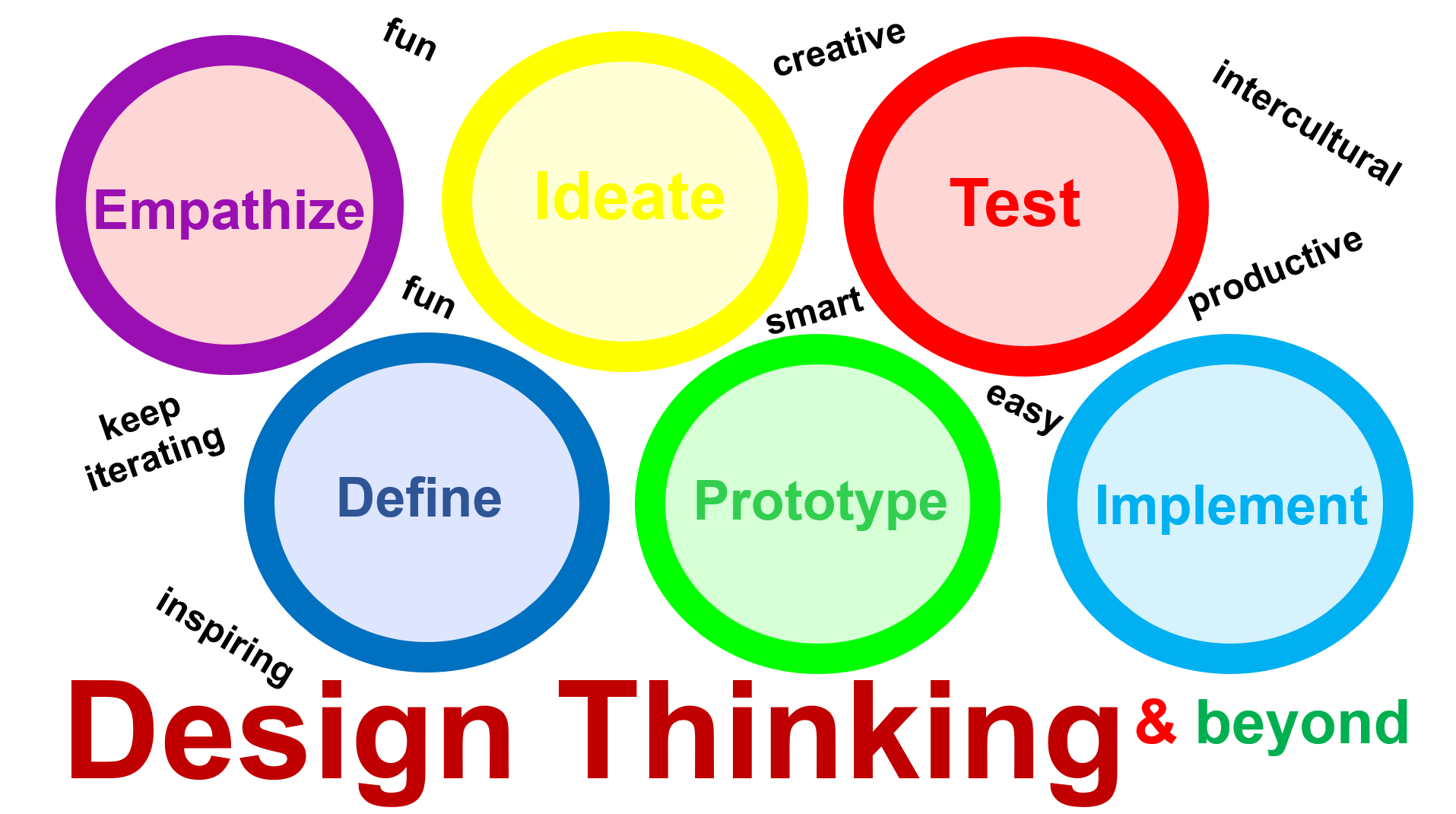Design Thinking workshop are a powerful problem-solving approach that fosters creativity and innovation. Since its introduction in it has become one of the most cherished methods for teams and individuals. Developed at the MIT and Stanford within their very tech-savvy environments it utilizes a few elements you would not necessarily expect in the standard designer’s toolkit.
Auf einen Blick - die Seitenübersicht
DesignThinking & beyond at one glance
DesignThinking and beyond workshop are a powerful problem-solving approach that fosters creativity and innovation. Here are the 6 key steps:
- Empathize: understand the users’ needs and experiences
- Define: articulate the core problem from a human-centered perspective as clearly as possible
- Ideate: generate diverse ideas using different methods of brainstorming, mindmapping, sketches etc
- Prototype: create tangible models or sketches to test the generated ideas
- Test: gather feedback from users and refine the solutions
- Iterate until final implementation: repeat the above steps until you have radically improved your product
If you ant to have more details, feel free to scroll down 🙂

Entering and enjoying the creative mindsets
The process works a lot easier when all participants are tuning into these 5 key mindsets. As a facilitator I always encourage these essential apporaches in the workshops:
- Human-centered: keep the users’ needs and experiences at the forefront of everything you do.
- Collaborative: embrace a multidisciplinary approach and involve different perspectives throughout the process.
- Iterative: be willing to try, fail, learn, and then try again. The process is not linear but cyclical.
- Creative: think beyond the obvious solutions and challenge assumptions
- Growth: don’t cling to old routines and habits but be ready to expand your pace of ideas
Ready, steady, go !
Now that we’ve covered the key steps and mindsets, let’s get ready to experience design thinking in action. Through hands-on activities and real-world examples, we’ll explore how this approach can help us create meaningful and impactful solutions to various challenges. Remember, design thinking is not just a methodology; it’s a way of thinking that can transform how we approach problem-solving in our personal and professional lives. So, let’s get started, and I hope you find this workshop both enjoyable and enlightening!
How it started
Design thinking emerged in the late 20th century, gaining prominence through firms like IDEO and Stanford University’s d.school. IDEO, a design consultancy firm, played a pivotal role in popularizing the concept and applying it to innovative product designs. The d.school, founded in 2005, further formalized design thinking as an academic discipline. Tim Brown, IDEO’s CEO, contributed to its widespread adoption through his article “Design Thinking” in Harvard Business Review (2008). Today, design thinking is widely embraced across various industries for its user-centered problem-solving approach.
Design thinking continues to evolve, and its principles have been adopted by numerous organizations and industries to foster innovation and user-centric problem-solving.
DesignThinking and the arts
For centuries new pieces of art have been developed in the workshops of artists – until they moved into the laboratories of private entrepreneurs and universities.
“DesignThinking and Beyond” helps you and your team to create truly innovative solutions.

Dive deeper, explore differently
For those of you who prefer examples let’s dive into the key steps of design thinking once again:
Empathize
The first step is all about understanding the people we are designing for – our users. We need to empathize with their needs, desires, and pain points. This involves conducting interviews, observations, and engaging with real users to gain insights into their experiences.
Define
After gaining empathy, we define the problem we want to solve. It’s crucial to reframe the problem in a human-centered manner. This step helps us clearly articulate the core issue and create a problem statement that focuses on the user’s perspective.
Ideate
Now comes the fun part – brainstorming and generating ideas. During this phase, there’s no judgment, and creativity is encouraged. We all aim to come up with a wide range of possible solutions to the defined problem.
Prototype
Once we have a bunch of ideas, it’s time to turn them into tangible prototypes. These can be low-fidelity models, sketches, or even role-playing scenarios. Prototypes allow us to test our ideas quickly and get feedback from potential users.
Test
In this step, we put our prototypes in front of real users and gather their feedback. Testing helps us understand which solutions resonate the most with users, what works well, and what needs improvement.
Iterate
Based on the feedback received during testing, we refine and improve our prototypes. The process of testing and refining may be repeated several times until we arrive at a desirable, feasible, and viable solution.
(This subpage received its last update in May 2023. Most of this website is available in proper English translation. Should you come across a topic only available in German we recommend you to use your fovorite translation service. At the moment we recommend deepl . Should you have any question please let us know by sending an email to info@eis-coaching.com)

